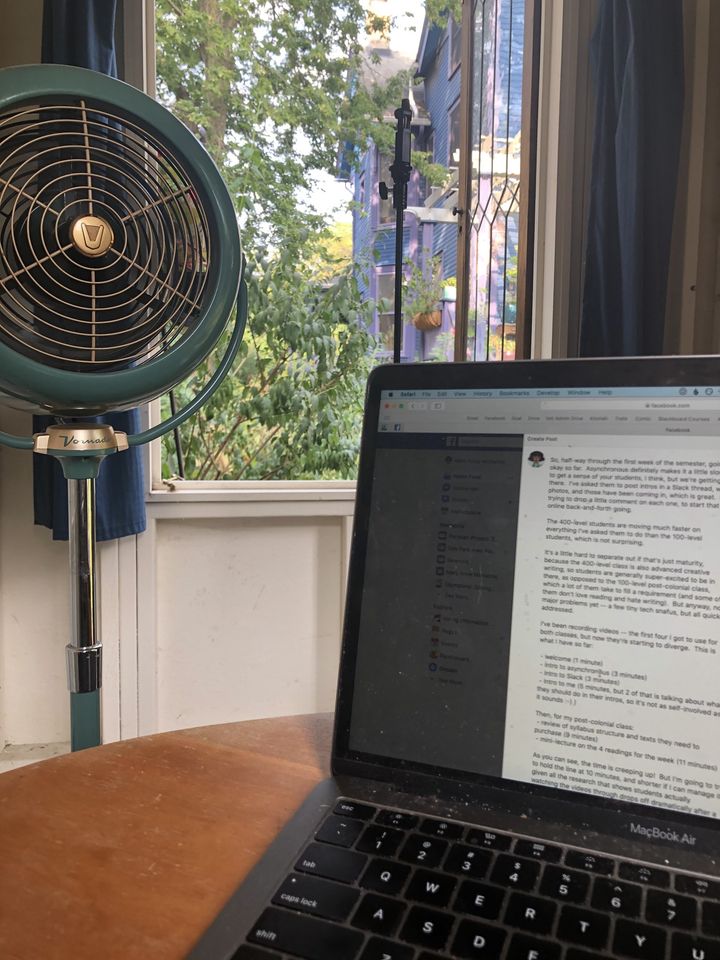So, half-way through the first week of the semester, going okay so far. Asynchronous definitely makes it a little slower to get a sense of your students, I think, but we’re getting there. I’ve asked them to post intros in a Slack thread, with photos, and those have been coming in, which is great. I’m trying to drop a little comment on each one, to start that online back-and-forth going.
The 400-level students are moving much faster on everything I’ve asked them to do than the 100-level students, which is not surprising.
It’s a little hard to separate out if that’s just maturity, because the 400-level class is also advanced creative writing, so students are generally super-excited to be in there, as opposed to the 100-level post-colonial class, which a lot of them take to fill a requirement (and some of them don’t love reading and hate writing). But anyway, no major problems yet — a few tiny tech snafus, but all quickly addressed.
I’ve been recording videos — the first four I got to use for both classes, but now they’re starting to diverge. This is what I have so far:
– welcome (1 minute)
– intro to asynchronous (3 minutes)
– intro to Slack (3 minutes)
– intro to me (5 minutes, but 2 of that is talking about what they should do in their intros, so it’s not as self-involved as it sounds ![]() )
)
Then, for my post-colonial class:
– review of syllabus structure and texts they need to purchase (9 minutes)
– mini-lecture on the 4 readings for the week (11 minutes)
As you can see, the time is creeping up! But I’m going to try to hold the line at 10 minutes, and shorter if I can manage it, given all the research that shows students actually watching the videos through drops off dramatically after a few minutes.
That means I can’t babble at length about each of these texts (which would be so easy to do), but that may be a good thing, helping to keep me focused. ![]()
We’ll be having the more complex discussions on Slack in text form; at least that’s the plan. We’ll try it for a week or two, see how it goes.
***
Overall, I’m aiming for being well-prepared, but also having great flexibility this semester; this is all a giant experiment, and I want to leave myself room to pivot to a different teaching mode if it seems like what I’m doing isn’t working.
(If Merriam-Webster doesn’t make ‘pivot’ the word of 2020, I’ll be disappointed!)
The plus side to that approach is that I didn’t have to do very much preparation in advance — I read about how to do online teaching well this summer, and took some tech tutorials, but I didn’t spend many hours recording a lecture for every class, the way some teachers did. I admit, given that we weren’t paid anything for all the extra work this summer (and the UI system has a lot of money in the bank, it’s not as if they’re about to crash and burn), I was pretty committed to not doing more than I had to in the summer.
But there IS a pandemic and we all have to chip in, and I do want my students to have a great semester. So I went with this approach, which balanced my need to save summer time for writing with the need to take good care of my students.
The main negative to the approach I picked, I think, is that it does require a lot of flexibility, mental nimbleness, and some tolerance for chaos, mostly for me, but a bit for my students too. I’m hopeful that it will be worth it, and that it’ll actually end up providing them a more engaging class than if I’d simply recorded 30 90-minute lectures. I also think this mode will do better at addressing diverse learning styles. We’ll have to wait and see, I think. ![]()
But I’ve done online teaching before, and I think I can give them both sufficient predictable structure and valuable flexibility. Fingers crossed!
(So far, I’ve been perching in this window to do my video recordings — it puts me at the right height for my tripod.)

